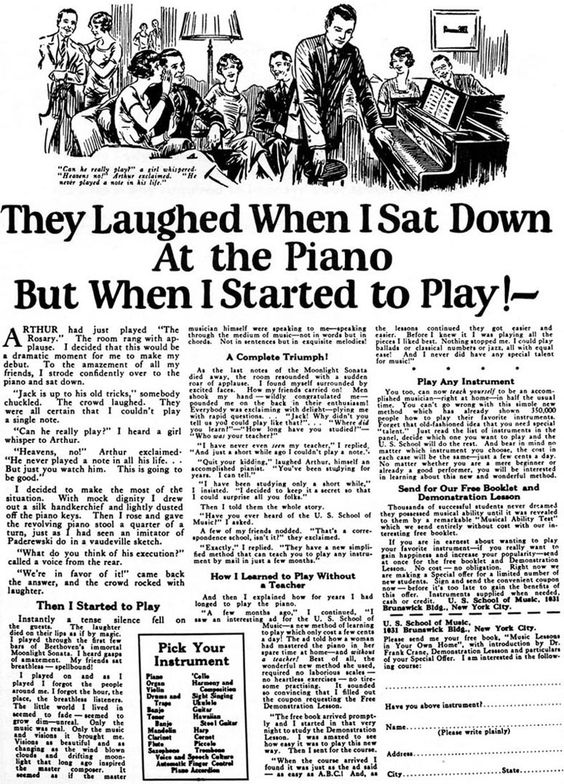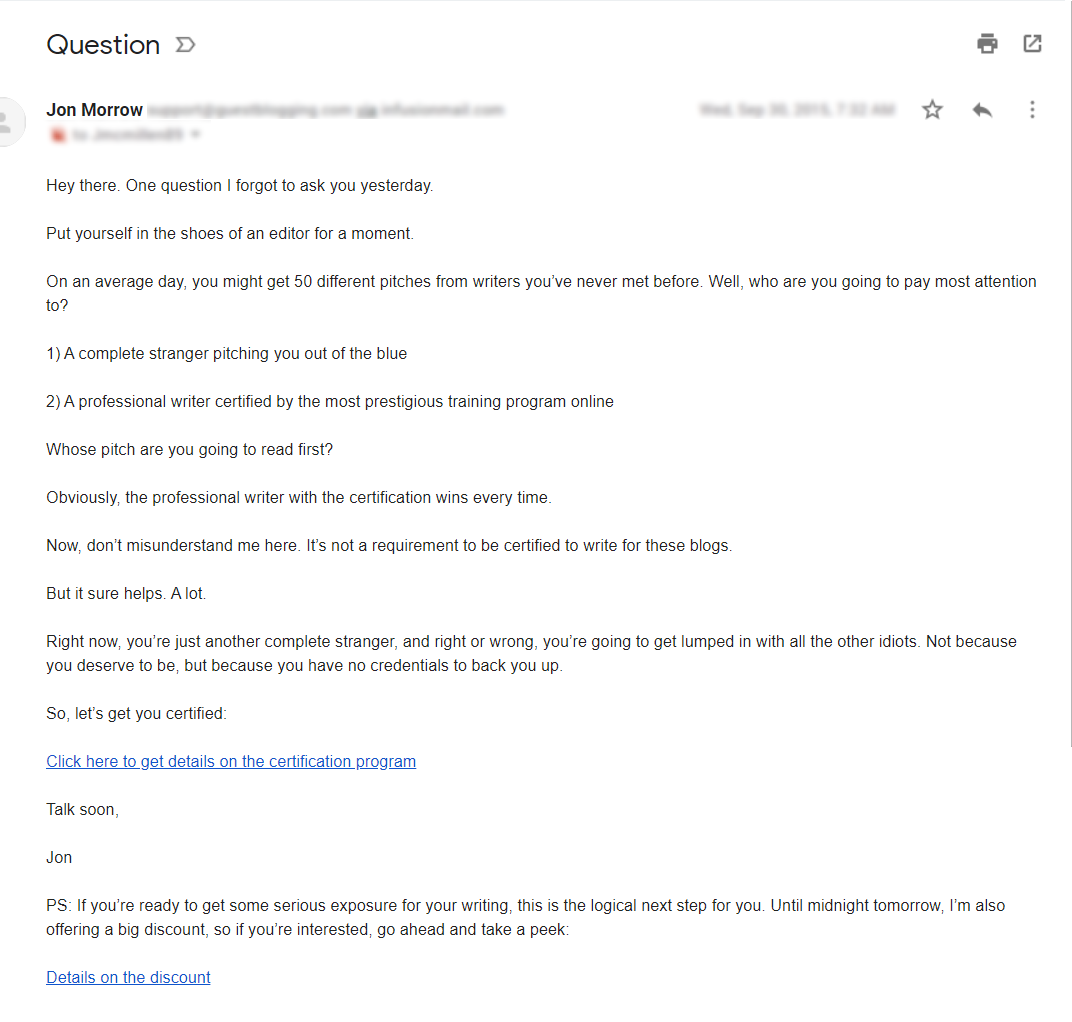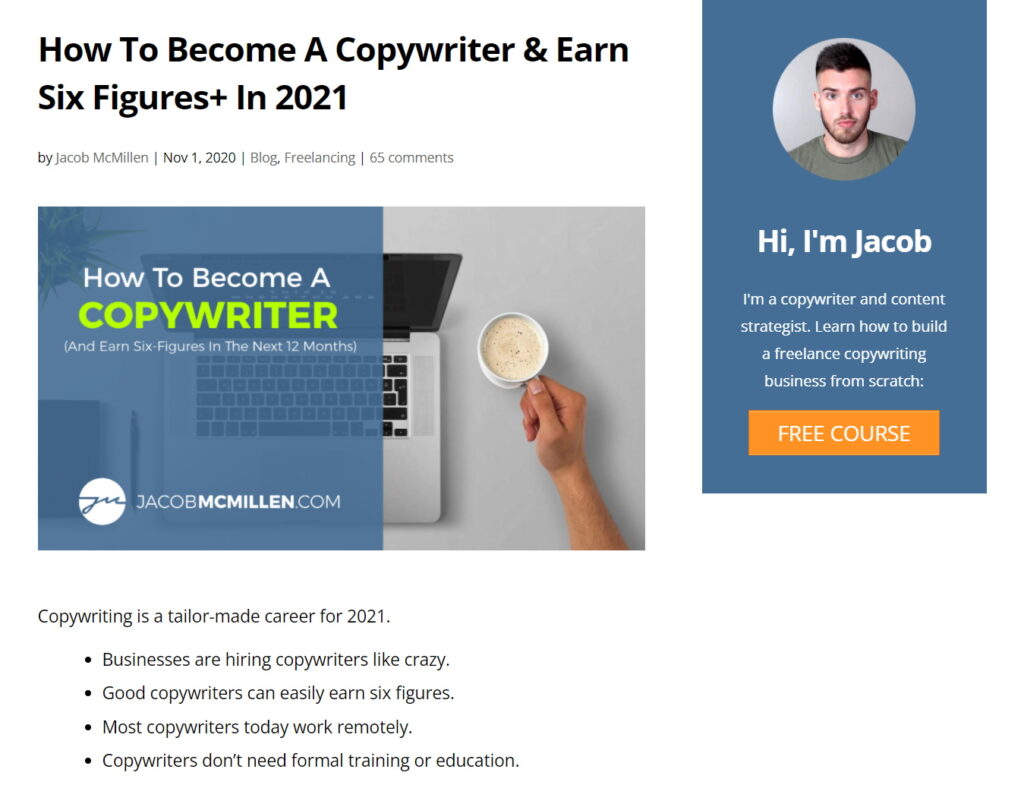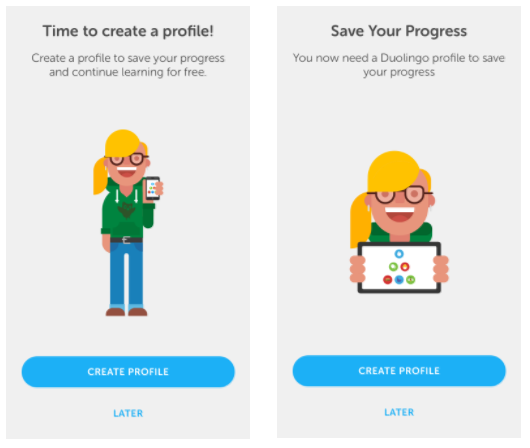Which types of copywriting are worth mastering right now?
In this guide, I’ll answer that question by walking you through the ten types of copywriting that will make you the MOST MONEY right now and over the next few years.
For each entry, we’ll break down:
- Why it’s in demand
- How much you can make
- Unique opportunities and challenges
Let’s dive in.
What Is Copywriting?
There’s only one source I trust to provide an accurate definition of copywriting.
Me… lol.
Plus, Google says my answer is best when you search “copywriting definition”, so I win.
Here’s my firsthand-experienced-and-heavily-researched definition of copywriting:
“The simplest copywriting definition is this: copywriting is the process of writing words intended to prompt a specific action by the reader. Copywriting is always connected to the act of promoting or selling a business, organization, brand, product, or service, which makes it, by definition, a form of marketing.”
Another way to describe copywriting is “sales writing”.
It’s writing with the goal of selling, persuading, promoting, etc.
Any time you read something online from a company that wants to sell you something, you are ready a type of copywriting.
Sometimes, what you are reading is trying to sell to you immediately, like when you read an ad on Facebook or an email from your favorite brand telling you about a limited time discount.
Other times, like right now, you are reading something where the goal is to either provide value to you or inform you about something. My goal is that you will find this article so helpful (and maybe even a little entertaining) that you will subscribe to my free copywriting course (take an action) and then potentially buy something from me down the road. Both those things make this blog post a type of copywriting… at least in my opinion.
As I mentioned before, you will get different answers depending on who you ask.
But I’m right, so listen to me.
Click here if you want to learn HOW to become a copywriter in the first place.
The 10 Types Of Copywriting Worth Learning TODAY!
Now that we have a baseline understanding of copywriting, let’s dive into the type of copywriting most worth learning today.
What makes a particularly type of copywriting worth learning?
Well, I’m assuming you are here to make money.
After all, copywriting is essentially sales writing. It’s all about bringing in dolla dolla bills… so that’s my criteria for this list:
- Can you make lots of money selling this type of copywriting as a service?
- Or can you make lots of money writing this copy for your own business?
These two criteria are essentially the same, because the more money a specific type of copywriting can make for a business, the more you stand to get paid writing that type of copywriting as a service.
In other words… potato/potata.
So with that said, here are the 10 types of copywriting that will make you the most money:
- Direct Response Copywriting
- Website Copywriting
- Email Copywriting
- Blog Copywriting
- Ad Copywriting
- SEO Copywriting
- Sales Page Copywriting
- Video Copywriting (Script Writing)
- UX Copywriting
- Social Media Copywriting
That might seem a bit overwhelming, but here’s some great news for you. You can make a TON of money learning only ONE of these types of copywriting!
In fact, I’d encourage you to start by mastering ONLY one, getting a bunch of real work under your belt, and then going from there.
Which one of these you pick is going to depend on your interests, skills, background, network, and potentially other factors as well…. OR it can be as simple as picking the one that sounds coolest.
Do you.
Type #1: Direct Response Copywriting
Direct response copywriting is writing intended to provoke a specific, immediate action from the reader… a “direct response” if you will.
Direct response copywriting used to be a very specific form of copywriting, primarily made up of longform ads like the one below and lengthy sales letters sent via direct mail.

The moniker “direct response” was coined to distinguish it from indirect marketing channels like like newspapers, radio, and television, where the vast majority of marketing budgets were spent.
As you’ve probably guessed, however, the internet completely flipped this on its head.
With the rise of ecommerce, things like online sales pages replaced sales letters as the go-to form of direct marketing, and direct, measurable advertising through Google and Facebook become the preferred choice over indirect advertising on television. US advertisers spent $143 Billion on digital ads in 2020 vs just $67 Billion on TV advertising.
Accordingly, when you ask most people what qualifies as “direct response copywriting” these days, they will respond with “sales pages” and “digital ads”.
But the truth is that in the online age, nearly every form of copywriting is aiming for a “direct response”.
- Most emails are written to drive a click or reply.
- Most website copy is written to drive a click, call, signup, or other immediate, defined action.
- Even most blog posts are aiming for a specific, immediate action, like an email signup or share.
- Most social copy is seeking some specific form of immediate interaction from the reader.
So if we define direct response copywriting as any form of copywriting attempting to drive immediate action, that pretty much covers all common forms of copywriting used online, including most of what we’ll cover in this guide.
Here’s a modern example, shared by Common Thread Collective:

These images include paid social, organic social, and SMS copywriting. Notice that in each case, the read is being pushed toward a direct response in the form of an immediate click.
So as we go through the rest of the types of copywriting in this guide, keep in mind that most of these are simply specific applications of direct response copywriting. There will be a lot of crossover as a result, which makes it pretty easy to learn multiple disciplines or switch between different ones throughout your career.
Type #2: Website Copywriting
Website copywriting is the writing done for static pages that make up a website, including the homepage, about page, service pages, contact page, etc.
The goal of website copywriting is to present a condensed, impactful overview of a brand and it’s core product or service offers to new and returning visitors.
This starts with the homepage, like the below example from Brillmark’s homepage, but it extends to all the core pages of the site.

Like with any form of copywriting, website copywriting should always have a clear primary goal. What this primary goal is will vary based on the type of business.
- For ecommerce businesses or businesses selling low-priced products, the primary goal will usually be to sell something to the visitor immediately.
- For SaaS businesses, the primary goal will usually be a free trial signup.
- For local services businesses, the primary goal will usually be to get the visitor to call the business immediately.
- For B2B service businesses or businesses with high-priced products, the primary goal will usually be to collect some form of contact information from the visitor — turning that visitor into a “lead” and allowing the brand to continue marketing to them to prepare them for a larger purchase down the road.
Website copywriting is typically written to be relatively static for an extended period of time. In my experience, the average business decides to redo their website copywriting every 5 years unless a large pivot causes them to require a rewrite on the sooner side.
There are an estimated 150 million businesses around the world, with 50 million new businesses started every year. That means that every year, 50 million new businesses need website copy and 30 million existing businesses are rewriting their website copy.
In other words, there is a virtually limitless demand for website copywriting around the world right now, with no sign of this demand slowing down anytime soon.
I’ve been a website copywriter for most of my career, and the gigs keep coming.
How can you take advantage of this limitless demand?
First, you need to learn how to write website copy. Click here to go through my free, comprehensive guide to website copywriting.
Second, you need to get in front of new and existing businesses that need website copywriting.
To get in front of existing businesses, your ticket will be pitching.
To get in front of new businesses, you’ll want to join communities for startup and small businesses founders and provide helpful advice. If you can become known in one of these groups as a helpful source of marketing and writing advice, many people in the group will hire you to write their copy for them when launching their business.
Type #3: Email Copywriting
Email copywriting is the writing done for any emails sent out by a brand or business.
There are two primary categories of email copywriting:
- copywriting for outbound marketing
- copywriting for inbound marketing
Outbound marketing is basically just cold sales. You are reaching out to lists of people who don’t know you, knowing that a small percentage of them will want or need what you are selling and buy from you.
Copywriting for outbound marketing consists primarily of cold outreach campaigns involving an initial email pitch and a series of follow-up emails.

These campaigns are often written once and then may or may not be tweaked based on results. They are often included in a broader “lead generation” packaged that marketers sell, and as a result, I don’t see a lot of freelance copywriter making a ton of money from outbound email copywriting.
Email for inbound marketing, however, is a whole different story.
Inbound marketing is a popular style of marketing that seeks to attract customers to the brand through educational, entertaining, or insightful content.
Nearly every successful inbound marketing campaign revolves around collecting email addresses.
The process looks something like this:
- Create content that attracts visitors via articles, podcasts, videos, or social posts.
- Collect email addresses from visitors by making email signup the path to accessing special content.
- Provide ongoing value to the email subscriber through a welcome sequence and ongoing emails.
- Sell products to the email subscribers periodically.
Here’s an example of email copywriting for inbound marketing from Jon Morrow:

Even from that brief summary and this one example, you can probably tell that this is NOT a simple process, AND it requires a whole lot of email copywriting.
That’s why this is a great opportunity for freelance copywriters to make a ton of money.
You can sell any of the following:
- Copywriting for Welcome Sequences
- Copywriting for ongoing emails to subscribers
- Copywriting for periodic or one-time Sales Sequences
Since this is where many businesses will make the majority of their revenue, copywriters who know what they are doing and have a proven track record can charge large amounts to create this type of email copy.
Just working on my own businesses with relatively small email lists, I’ve had a single email result in $11,000 in sales and a single sales sequence result in $32,000 in sales. I currently have projects in place with much larger brands that will result in much larger paydays based in part on my copywriting.
And just like with website copywriting, virtually every business trying to make money online SHOULD be using email marketing.
They aren’t… but they should be… and millions join the ranks every day.
Unlike website copywriting, email marketing requires new emails EVERY WEEK, so once again, we have a type of copywriting with virtually limitless demand.
How can you take advantage?
First, you need to learn how to write email copy. Click here to go through my free, comprehensive guide to email copywriting.
Second, you need to get in front of new and existing businesses that need email copywriting.
Pitch existing businesses or provide value to targeted groups of founders and entrepreneurs, just like we talked about before.
Type #4: Blog Copywriting
Blog copywriting is writing intended to attract readers to a brand as part of a broader inbound marketing campaign.
Remember Step #1 in the inbound marketing process that we covered previously?
1. Create content that attracts visitors via articles, podcasts, videos, or social posts.
10 years ago, this was done almost exclusively through articles, but over the last decade, videos, social posts, and even podcasts have become major players in attracting new visitors and customers to brands around the world.
That said, if you want to tap into the 2 Trillion daily searches processed by Google, articles are still your best shot, and that’s why hundreds of thousands of businesses continue investing billions in article creation.
For example, this article brings 500 people interested in learning copywriting to my website every single day.

To put this into perspective, I have around 6,000 followers on Linked and 14,000 followers on Twitter. I get pretty respectable engagement when I post on both platforms, and I don’t even get a combined 500 site visits PER MONTH from these platforms, even when I’m posting frequently.
That’s a big discrepancy.
And while most of the articles on my site don’t perform nearly that well, every new article permanently adds to the total number of visitors I have coming to my site each month.
So what’s the catch?
The catch is that I’m really, really good at writing “longform” content that people actually want to read AND that ranks in Google.
90% of blog articles will never be read by anyone other than the person who writes them.
You can still get paid to write those articles… yes, even the ones nobody is reading.
But if you want to make really good money, there are few as in-demand skills as the ability to write exceptional articles that do a 2,000+ word deep dive into a subject people care about.
I can go make $1,500 – $2,500 per article to write this type of content any time I want. It’s kind of nuts.
I also know more writers earning $15k+ per month solely on this type of writing than any other type on this list, so if you want a good place to start, this is it.
How can you tap into this lucrative demand?
If you are just getting started, start with this amazing free guide from my friend Ryan Robinson.
If you have been writing blog posts for awhile, and you are ready to hit that next level, I’d recommend grabbing my masterclass on longform & SEO.
Type #5: Ad Copywriting
Ad copywriting is writing done for advertising campaigns with the intent to make an impression or drive an immediate action.
The fastest way to get customers, especially as a new business, is via advertising.
You pay money and immediately get your product or service in front of real people.
As we talked about earlier, traditional advertising had the goal of making an impression on the reader that would stick with them long enough to result in a purchase. Potential customers would see an ad, take note of the brand or product, and eventually purchase from the brand based on that impression (and often a series of repeated impressions from multiple ads).
Today, the majority of advertising dollars are spent on internet advertising, which is nearly always delivered with the goal of an immediate click.

Additionally, advertising done in traditional media has evolved to often seek a direct response, with many radio and tv ads instructing viewers to immediately call a number or visit a website.

North American companies alone spend $250 Billion on advertising in 2020.
100% of those ads required some form of copywriting. Even video ads with no text required a script.
Additionally, advertisers are rarely able to succeed via the same ad for lengthy periods of time. Brands are constantly having to adjust, rewrite, and create new ads to keep ad performance strong. That means ongoing work for copywriters.
Best of all, ad copywriting is one of the most measurable forms of advertising. Since ad campaigns are direct response and highly monitored, performance data is not only easy to access, but inescapable. If you are working on ad campaigns, you will nearly always be shown the data, making improvement and mastery much faster than in other forms of copywriting.
So how do you get into ad copywriting?
Unlike the previous three types of copywriting we’ve discussed, ad copywriting isn’t often hired out to freelancers. Instead, the entire ad campaigns are usually hired out to agencies or done in-house.
This means the most accessible path to mastering ad copywriting is to go work for an advertising agency as a staff copywriter.
You can also attempt to learn advertising from start to finish and work as a freelance ad specialist who writes the copy as part of that service. There is a lot of demand for that type of work from companies that can’t quite afford to work with an agency. Just keep in mind that you will need to master a lot more than just the copywriting to offer that service. You’ll need to learn and master a specific advertising platform like Google, Facebook, Pinterest, etc.
If you are looking for an initial guide to ad copywriting, check out this great piece from my friends at KlientBoost.
The KlientBoost blog also has individual guides to specific types of advertising, so you can dive into those as well if you feel like advertising is your calling.
Type #6: SEO Copywriting
SEO copywriting is writing intended to rank a page or blog post in Google Search for a specific keyphrase.
This article is an example of “SEO copywriting” in that I wrote it with the goal of ranking for the search term “types of copywriting”, as well as searches with similar intent.
SEO stands for “Search Engine Optimization” and it means trying to make your website show up in Google Search when potential customers are searching for things relevant to your brand.
While advertising is the fastest way to get customers, SEO is one of the most efficient and scalable.
With advertising, you need to pay every single time you want someone to see your brand.
With SEO, you pay upfront to rank your brand in search, and then that investment turns into new visitors to your site every single month, even without you spending additional money. That’s why US companies alone spent $80 Billion on SEO in 2022.
At least, that’s how it works in theory.
Unlike advertising, SEO is a zero-sum game.
When you search “types of copywriting”, there is only ONE #1 position, and 34% of users are going to click it. That drops to 17% for the #2 spot and so on, as this graphic from Sistrix illustrates.
When you invest money in advertising, the results are solely based on your own skill as a company at communicating the right message and delivering a good product/market fit.
When you invest money in SEO, you are competing for a handful of spots, often against competitors who are spending more than you and have been doing so for longer.
And what determines who wins those coveted spots?
In many cases, it’s whoever has the better SEO copywriter.
This is the type of writing I’m best at — probably top 50 in the world — and as a result, I’ve been able to consistently outrank competitors with significantly larger budgets, both for my own businesses and those of my clients.
If you want to learn how to do the same, click here to read my free SEO copywriting guide.
If you already know what this is all about and you are really serious about mastering it, check out my longform & SEO masterclass.
Type #7: Sales Page Copywriting
Sales page copywriting is writing for a webpage focused solely on immediately selling a single product or service to the reader.
You know a sales page when you see it.
- Lot’s of writing.
- Very emotional, problem-focused copy.
- No way to navigate elsewhere on the website.
- Only option is to buy or leave.
Here’s an example from my own website.

The online sales page is descended from the direct mail sales letters we talked about earlier. It’s goal is to turn readers into buyers and it’s very, very easy to measure how well it accomplishes that goal.
When people want to sell something specific online, there are basically two ways to do it:
- Get someone on the phone and sell it to them 1-to-1.
- Send them to a sales page and sell them via writing.
The first option is a lot easier and a lot more expensive. Live sales come with a lot of advantages that I discuss in this guide to selling over the phone.
But it also means you need a person doing each sale individually. That’s time consuming and expensive.
A great sales page lets you sell to a limitless number of people, ongoing, with no additional work.
And that’s why if you can write a sales page that performs well, you can make a lot of money.
A LOT of money.
To give you an example, I recently made $3,000 to EDIT a sales page.
I didn’t even write it from scratch.
It’s not uncommon for copywriters to charge $5-10k to write ONE page from the ground up.
And while I’m skeptical of many of these claims, there ARE absolutely copywriters out there who work out commission deals with companies where they make a percentage of the total sales of the page.
When people talk about making massive amounts from single projects (we are talking high five-figures or even six-figures), this is the scenario they are always referencing: commission from a sales page or an email sequence into a sales page.
Want to learn how to write a high-performing sales page? Start with this guide from GrowthLab.
Type #8: Video Copywriting (Script Writing)
Video copywriting, more commonly referred to as “script writing”, is writing words that will be delivered via spoken word as part of a video or audio recording rather than read in written format by a reader.
When you create a video, you are usually either recording something live and spontaneous OR you are recording something scripted. If you need your video to accomplish something specific, you nearly always need a script, which means you nearly always need a writer.
Currently, there are two main ways that video copywriters can make significant money.
- Video Sales Letters (VSL)
- Webinars
Both of these are essentially just sales pages (like we just talked about) in video format. They take viewers through a very similar process to a sales page and are used in much the same way as a sales page.
Beyond that, there hasn’t been a lot of money in scriptwriting for the average freelancer, but I think that’s going to change.
There are a lot of statistics and examples I could show you to highlight the ways video is changing culture and how we purchase things.
But they are all insignificant compared to the rise of Tiktok.
If you are under 30 years old, you are already aware of how remarkably Tiktok has shifted culture in the US and really across the entire world.

Every song you hear on the radio today is being played because it’s connected to a viral Tiktok clip.
Influencers and brands have appeared out of thin air and immediately crossed 8-figures due to this platform.
If you want to get in front of someone under 30 today, Tiktok — a platform barely anyone was using just 3 years ago — is now your best option.
I’ve watched a lot of social platforms gain popularity in marketing over the last 10 years, and Tiktok represents the type of unprecedented cultural paradigm shift we haven’t seen since Facebook opened up to non-college users.
The future of content is video. It’s unscripted video. It’s scripted video. It’s live, recorded, longform, shortform, and everything in between.
A lot of this video creation does not require copywriting, but a lot of it does, and as we’ve already started to see on Tiktok, once the flood of unscripted, spontaneous video gets large enough, the only way to rise above the noise is to create something more intentional, more produced, and more scripted.
And so when we talk about types of copywriting worth mastering, it’s hard to imagine something with more future potential than video copywriting.
Even today, there is extremely lucrative demand for writers who can put together webinar scripts that perform well via advertising.
But in the near future, video copywriting for all types of videos will be outsourced to writers, and based on the market we’ve seen over the last decade, a large chunk of that demand will go to freelancers.
If you want to start learning this skillset, check out this fantastic guide by my friend Ame Proietti.
To dig more into video marketing as a whole, check out this guide by Wistia.
Type #9: UX Copywriting
UX copywriting is writing intended to help the reader use an app, product, or service.
UX stands for “User Experience” and involves a lot more than copywriting.
- For an app, it involves design, transitions, bug-fixing, integrations, and much more
- For a physical product, it involves the quality, usability, the unboxing experience, and more
- For a service, it involves onboarding, reporting, feedback, and more
But within the combined set of experiences that constitutes the “User Experience” across each of these categories, there is ALWAYS writing.
Sometimes it’s just the title and small line or two:

Sometimes it’s in-depth creative descriptions intended to enhance the experience:

Sometimes it’s just helpful, fun directions to take you to the next screen:

UX copywriting requires a meticulous mindset and a great deal of attention to detail.
As far as copywriting is concerned, it’s sort of in a class unto itself, and as someone who is not a UX copywriter, it’s also the type of copywriting I know the least about.
What I can tell you is that it’s difficulty and unique approach results in it paying very well, so if you are interested in pursuing this type of copywriting, check out this piece by Joe Daniels.
Type #10: Social Media Copywriting
Social media copywriting is writing for organic (non-paid) social media posts.
You may notice that I didn’t add anything about the intent of the posts, and that’s because the intent (and really everything else) can vary wildly from post to post and channel to channel.
This is what makes social media so challenging.
Within the course of a week, you might need to entertain, educate, inform, sell, and save face… all of which require completely different skill sets.
Talented, strategic social media managers are some of the most underappreciated people in marketing, and if you are writing for organic social, you likely will be as well.
This is partly due to brands still having absolutely no clue what social media is all about, and it’s partly due to popular social platforms systematically stripping away organic reach and dismantling years of well-planned value built by social media marketers.
“Wow Jacob, you’re really hard selling me on this whole social media copywriting thing. Ease off their buddy.”
Yeah I know.
Here’s the flipside to all this.
- Social media continues to play a pivotal role in online business.
- Small businesses are willing to pay newcomers for social media management without understanding anything or having specific goals.
- Specific social channels like Twitter and LinkedIn have stabilized their organic reach at a position that is still very profitable for businesses.
- Social presence has become business capital for personal brands.
- Ecommerce remains on an increasingly social trajectory.
That’s a diverse list of points, so let me sort of summarize what it means to you as a copywriter looking to build your career.
For starters, very few marketing channels provide the early career sandbox that social media can give you as a writer. You can close gigs with virtually zero expectations, because small businesses don’t understand what’s going on. They just believe they need social media.
If you take it seriously, this is also a phenomenal learning opportunity where you can essentially create your own opportunities by actually succeeding where nobody expects anything.
You can learn on your clients’ dime, and then you can apply that knowledge to your own personal brand on social media, and with each passing year, the value of social presence increases. When you have a large social following, you can essentially choose your own adventure as an entrepreneur and make money in any direction you travel.
And finally, if you do really get good at this, the opportunities will be endless, because despite the rise and fall of individual social channels, the overall trajectory of ecommerce is decidedly social, and we are essentially all just gearing up for the metaverse, where everything will be social.
If you want to learn how to write for social media, check out this amazing guide from my friend Julia McCoy.
Want To Build A Freelance Copywriting Business?
Each of the copywriting disciplines we covered in this guide represent opportunity, but what holds most copywriters back from success isn’t their writing expertise or experience… it’s their ability to get clients and run an actual business.
If you want to learn how to take your writing skills and consistently turn them into money, enter your email below, and I’ll send you my freelance copywriting crash course, completely free.





